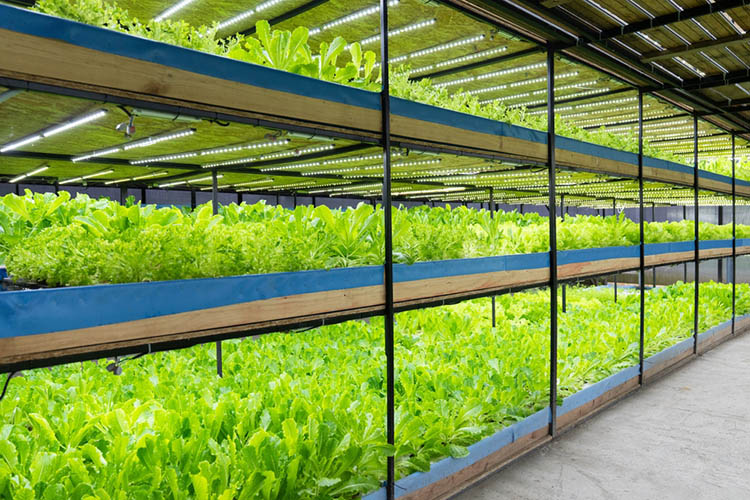Smart lighting could be key to making vertical farming more cost-effective
- Like
- Digg
- Del
- Tumblr
- VKontakte
- Buffer
- Love This
- Odnoklassniki
- Meneame
- Blogger
- Amazon
- Yahoo Mail
- Gmail
- AOL
- Newsvine
- HackerNews
- Evernote
- MySpace
- Mail.ru
- Viadeo
- Line
- Comments
- Yummly
- SMS
- Viber
- Telegram
- Subscribe
- Skype
- Facebook Messenger
- Kakao
- LiveJournal
- Yammer
- Edgar
- Fintel
- Mix
- Instapaper
- Copy Link
Posted: 24 September 2024 | Ben Cornwell | No comments yet
Scientists have discovered how tailoring light conditions in vertical farms could reduce energy costs and improve plant health. This breakthrough could help make vertical farming systems more sustainable and scalable, addressing the challenge of feeding a growing global population.


According to new research, vegetables like these growing in indoor vertical farms could benefit from smart lighting.
To continue feeding the world’s growing population, innovation is crucial. Vertical farming, which cultivates crops in controlled indoor environments, is one such solution. However, scaling up these systems presents significant challenges, particularly the high energy demands associated with providing light for plant growth. Now, scientists have demonstrated that tailoring light conditions based on the needs of specific crops can not only enhance plant health but also reduce energy consumption.
Dr Elias Kaiser, lead author of the article published in Frontiers in Science, highlighted the potential of vertical farming to revolutionise food production, particularly in challenging environments. “The biggest benefit of vertical farming systems is that healthy food can be grown much more closely to consumers in places where this is otherwise impossible: in mega-cities, in deserts, and in places that are cold and dark for large parts of the year,” he explained. Although, he also pointed to the significant costs associated with electricity use, which is a major barrier to widespread adoption.
A smarter approach to lighting
One of the key inefficiencies in current vertical farming systems is the reliance on constant environmental conditions, which require substantial amounts of electricity, particularly for maintenance. This is especially true for lighting, which is essential for photosynthesis. But, the researchers of the study argue that such uniformity is unnecessary. Instead, they propose a dynamic environmental control system that adapts lighting based on crop needs, reducing energy use and costs while maintaining plant health.
Professor Leo Marcelis of Wageningen University, senior author, commented: “We were motivated by the rhythms that plants show on diurnal as well as on developmental timescales, which require their growing environment to be adjusted regularly in order to steer their growth perfectly.”
He added, “We outlined a strategy that makes use of plant physiology knowledge, novel sensing and modelling techniques, and new varieties specifically bred for vertical farming systems.”
Plants’ biological processes are influenced by variables such as temperature, light wavelengths, and CO₂ levels. By manipulating these factors, farmers can influence plant development. Crucially, light intensity and quality are highly sensitive to electricity prices, presenting an opportunity for cost savings.
“Fluctuations in electricity prices can be used to the advantage of vertical farming systems by using more electricity when it is cheaper,” explained Marcelis.
A breakthrough in energy efficiency
The research team developed a model to test how smart lighting systems could keep plants’ photosynthetic ability stable throughout the day, while reducing energy use and costs. They found that optimising light intensity could cut electricity costs by 12 percent without affecting the plants’ carbon fixation, simply by varying the intensity of the light.
When the team tested this approach on leafy greens like spinach, a staple of vertical farms, they found no negative impact on growth, even when the light intensity fluctuated irregularly.
Future challenges and opportunities
While these findings represent a major step forward, significant hurdles remain before vertical farming can reach its full potential. “Many of the proposed solutions have not been tested at the larger scales that vertical farms represent—they may have been shown at the single-plant level, but not yet at the whole crop stand level,” cautioned Kaiser.
Dynamically adjusting airflow, temperature, and CO₂ levels to match the needs of plants could help reduce electricity costs in vertical farming. To achieve this, farmers will need advanced sensors and models to monitor and fine-tune the growing environment.
Additionally, new plant varieties specifically bred for vertical farming will be essential. These varieties can focus on improving nutritional value and taste, as they benefit from controlled, local growing conditions, rather than needing to prioritise durability or shelf life. But, further research is needed to fine-tune these factors and find the right balance between crop quality and yield.
“In a vertical farm, all growth conditions can be exactly controlled, which is very important to optimise yield, quality, and resource use efficiency,” said Marcelis. “However, the technical possibility of keeping them constant does not mean that keeping them constant is the best solution. Once dynamic environmental control has become established, both the energy use and costs of the energy used can be substantially reduced, increasing the profitability and sustainability of vertical farms.”
Related topics
Data & Automation, Environment, Equipment, Food Security, Research & development, Technology & Innovation
Related regions
Asia Pacific & Oceania, Central and South Asia, Europe, North America









